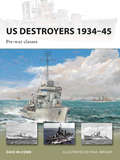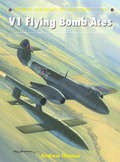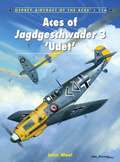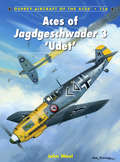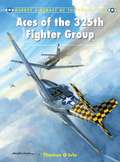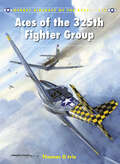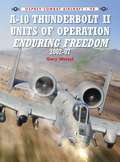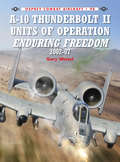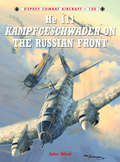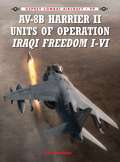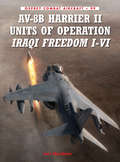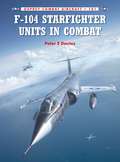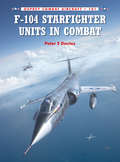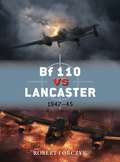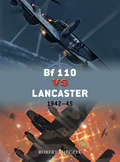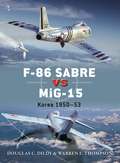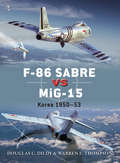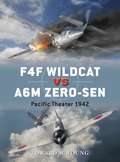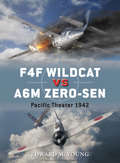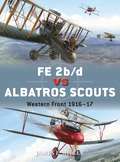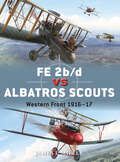- Table View
- List View
US Destroyers 1934–45: Pre-war classes (New Vanguard #162)
by Mr Paul Wright Dave McCombSince the beginning of the 20th century, destroyers have been all-purpose ships, indispensable in roles large and small – from delivering the mail at sea to screening other vessels and, where larger ships were not present, forming the front line in battle. This title details the 169 ships of ten classes introduced in the 1930s: early 1,500-tonners and 1,850-ton destroyer leaders designed to conform to the 1930 London Naval Treaty, plus the successor 1,570-ton Sims class and 1,620and 1,630-ton Benson and Gleaves classes. In wartime, most 1,500-tonners and leaders initially saw front line duty in the Pacific but were relegated to secondary assignments as newer vessels arrived; while the later 1,620and 1,630-tonners became the standard destroyers of the Atlantic War. This volume reveals the fascinating design story behind these pioneering classes – from the constraints of peacetime treaties to advances in propulsion engineering, and wartime modifications. With an operational overview of their service and tables listing all ships by class, builder, and initial squadron, this is the definitive guide to the pre-war US destroyer classes.
V1 Flying Bomb Aces (Aircraft of the Aces)
by Chris Davey Andrew ThomasShortly after the Allied landings in France the Germans unleashed the first of their so-called 'revenge weapons', the V1 flying bomb. Launched from specially constructed sites in northern France, the fast, small, pulse-jet powered pilotless aircraft were aimed at London with the sole intent of destroying civilian morale to the point where the British government would be forced to sue for peace. This dangerous new threat drew an immediate response, and the Air Defence of Great Britain (as Fighter Command had been temporarily renamed) established layers of defence that included a gun line and balloon barrage. The main element, however, were standing patrols by the fastest piston-engined fighters available to the RAF – the new Tempest V and Griffon-powered Spitfire XIV. Other types were allocated too, most notably the Polish Mustang wing, while night defence was left in the capable hands of several dedicated Mosquito squadrons. Although pilotless, the V1 was no easy foe thanks to its speed, powerful warhead and sheer unpredictability. Nevertheless, 154 pilots became V1 aces, 25 of whom were also aces against manned aircraft.
V1 Flying Bomb Aces (Aircraft of the Aces #113)
by Andrew Thomas Mr Chris DaveyShortly after the Allied landings in France the Germans unleashed the first of their so-called 'revenge weapons', the V1 flying bomb. Launched from specially constructed sites in northern France, the fast, small, pulse-jet powered pilotless aircraft were aimed at London with the sole intent of destroying civilian morale to the point where the British government would be forced to sue for peace. This dangerous new threat drew an immediate response, and the Air Defence of Great Britain (as Fighter Command had been temporarily renamed) established layers of defence that included a gun line and balloon barrage. The main element, however, were standing patrols by the fastest piston-engined fighters available to the RAF – the new Tempest V and Griffon-powered Spitfire XIV. Other types were allocated too, most notably the Polish Mustang wing, while night defence was left in the capable hands of several dedicated Mosquito squadrons. Although pilotless, the V1 was no easy foe thanks to its speed, powerful warhead and sheer unpredictability. Nevertheless, 154 pilots became V1 aces, 25 of whom were also aces against manned aircraft.
Ki-61 and Ki-100 Aces (Aircraft of the Aces)
by Nicholas Millman Ronnie OlsthoornThis is the story of the elite Japanese Army Air force (JAAF) aces that flew the Kawasaki Ki-61 Hien (Swallow), and the Ki-100 Goshikisen in the Pacific Theatre of World War 2. The former, codenamed 'Tony' by the allies, was a technically excellent aircraft, possessing power, stability and a good rate of climb - differing radically from the usual Japanese philosophy of building light, ultra-manoeuvrable fighters. Its pilots soon realised, however, that the type was plagued by a number of dangerous mechanical issues. Then as the war moved relentlessly closer to Japan's doorstep, a desperate, expedient innovation to the Ki-61 airframe by fitting it with a radial instead of inline engine resulted in one of the finest fighters of World War 2 - the Ki-100. This book uses the latest findings to provide a gripping account of some of the most remarkable and hard-pressed fighter pilots of the war. It reveals how these men, unlike so many of their unfortunate late-war colleagues, could surprise Allied aircraft in high-performance fighters and claim successes in the face of enormous odds.
Ki-61 and Ki-100 Aces (Aircraft of the Aces #114)
by Nicholas Millman Ronnie OlsthoornThis is the story of the elite Japanese Army Air force (JAAF) aces that flew the Kawasaki Ki-61 Hien (Swallow), and the Ki-100 Goshikisen in the Pacific Theatre of World War 2. The former, codenamed 'Tony' by the allies, was a technically excellent aircraft, possessing power, stability and a good rate of climb - differing radically from the usual Japanese philosophy of building light, ultra-manoeuvrable fighters. Its pilots soon realised, however, that the type was plagued by a number of dangerous mechanical issues. Then as the war moved relentlessly closer to Japan's doorstep, a desperate, expedient innovation to the Ki-61 airframe by fitting it with a radial instead of inline engine resulted in one of the finest fighters of World War 2 - the Ki-100. This book uses the latest findings to provide a gripping account of some of the most remarkable and hard-pressed fighter pilots of the war. It reveals how these men, unlike so many of their unfortunate late-war colleagues, could surprise Allied aircraft in high-performance fighters and claim successes in the face of enormous odds.
Aces of Jagdgeschwader 3 'Udet' (Aircraft of the Aces)
by John WealJagdgeschwader 3 may not have the same immediate resonance as some of the more famous Luftwaffe fighter units, such Jagdgeschwader 2 'Richthofen', but it is arguably the archetypal German fighter formation of World War 2. Not only did it participate in every campaign fought by the Luftwaffe (with the exceptions of Poland and Norway), it flew every major variant of the two legendary German wartime fighters, the Messerschmitt Bf 109 and the Focke-Wulf Fw 190 – starting with the Bf 109E in 1939 and ending with the Fw 190D-9 'Long-nose' in 1945. And, during the course of the hostilities, it numbered among its ranks more than 70 Knight's Cross winners (a total exceeded by only one other Jagdgeschwader). The wealth and variety of detail afforded by such a background – which includes the historic battles of Britain, Stalingrad, Kursk, Normandy, the Ardennes and Berlin – provides an ideal framework upon which to portray the multitude of stories, exploits and ultimate fates of the many aces themselves, from the now unknown trio who achieved their first five kills during the Blitzkrieg in France in the late spring/early summer of 1940 to the nearly two-dozen highly acclaimed and lauded 'centurions' who flew with JG 3.
Aces of Jagdgeschwader 3 'Udet' (Aircraft of the Aces #116)
by John WealJagdgeschwader 3 may not have the same immediate resonance as some of the more famous Luftwaffe fighter units, such Jagdgeschwader 2 'Richthofen', but it is arguably the archetypal German fighter formation of World War 2. Not only did it participate in every campaign fought by the Luftwaffe (with the exceptions of Poland and Norway), it flew every major variant of the two legendary German wartime fighters, the Messerschmitt Bf 109 and the Focke-Wulf Fw 190 – starting with the Bf 109E in 1939 and ending with the Fw 190D-9 'Long-nose' in 1945. And, during the course of the hostilities, it numbered among its ranks more than 70 Knight's Cross winners (a total exceeded by only one other Jagdgeschwader). The wealth and variety of detail afforded by such a background – which includes the historic battles of Britain, Stalingrad, Kursk, Normandy, the Ardennes and Berlin – provides an ideal framework upon which to portray the multitude of stories, exploits and ultimate fates of the many aces themselves, from the now unknown trio who achieved their first five kills during the Blitzkrieg in France in the late spring/early summer of 1940 to the nearly two-dozen highly acclaimed and lauded 'centurions' who flew with JG 3.
Aces of the 325th Fighter Group (Aircraft of the Aces)
by Chris Davey Tom IvieThe 325th FG was activated under General Order number 50 on 30 July 1942 and set up training operations at Theodore F Greene Field in Providence, Rhode Island. By mid-December 1942 the group was considered ready for combat and the alert for overseas duty arrived on 2 January 1943. The pilots and their P-40s departed on the carrier USS Ranger on 8 January and flew their aircraft off the vessel into Cazes airfield, near Casablanca, on 19 January 1943. After the remainder of the personnel arrived in late February, the group prepared for combat, and finally flew its first mission on 17 April 1943 as part of the Twelfth Air Force. During the next four months it participated in the North African campaign, and operations against enemy-held islands in the Mediterranean Sea. By the end of the Sicilian campaign on 17 August the 325th FG had scored 128 aerial victories, been the first P-40 unit to deliver 1,000-lb bombs against enemy targets and had escorted 1,100 bombers without losing a single one of them to enemy action.
Aces of the 325th Fighter Group (Aircraft of the Aces #117)
by Tom IvieThe 325th FG was activated under General Order number 50 on 30 July 1942 and set up training operations at Theodore F Greene Field in Providence, Rhode Island. By mid-December 1942 the group was considered ready for combat and the alert for overseas duty arrived on 2 January 1943. The pilots and their P-40s departed on the carrier USS Ranger on 8 January and flew their aircraft off the vessel into Cazes airfield, near Casablanca, on 19 January 1943. After the remainder of the personnel arrived in late February, the group prepared for combat, and finally flew its first mission on 17 April 1943 as part of the Twelfth Air Force. During the next four months it participated in the North African campaign, and operations against enemy-held islands in the Mediterranean Sea. By the end of the Sicilian campaign on 17 August the 325th FG had scored 128 aerial victories, been the first P-40 unit to deliver 1,000-lb bombs against enemy targets and had escorted 1,100 bombers without losing a single one of them to enemy action.
A-10 Thunderbolt II Units of Operation Enduring Freedom 2002-07 (Combat Aircraft #98)
by Jim Laurier Gary WetzelThe A-10 was never a favourite amongst the USAF's senior staff, and prior to Iraq's invasion of Kuwait in 1990 they had attempted to transfer the aircraft to the US Army and Marine Corps. Reprieved from premature retirement, the A-10 would see combat in the Balkans during the mid-1990s and over Iraq in Operations Northern Watch and Southern Watch until Operation Iraqi Freedom began in 2003. Following the 11 September 2001 attacks in the United States, the Bush administration responded with the instigation of Operation Enduring Freedom. A-10 aircraft first entered the fray during Operation Anaconda in March 2002. During Anaconda four A-10s flying from Pakistan provided 21 straight hours of FAC (A)/CAS coverage. The untold story of the A-10 in Enduring Freedom will be explored and presented as never before through first hand interviews and photography from those involved, along with official military achieves. This title is the first of three planned covering the combat experience of the USAF's A-10 Thunderbolt II units. Follow-on volumes will examine the role of the Warthog during Operation Desert Storm and Operation Iraqi Freedom.
A-10 Thunderbolt II Units of Operation Enduring Freedom 2002-07 (Combat Aircraft #98)
by Jim Laurier Gary WetzelThe A-10 was never a favourite amongst the USAF's senior staff, and prior to Iraq's invasion of Kuwait in 1990 they had attempted to transfer the aircraft to the US Army and Marine Corps. Reprieved from premature retirement, the A-10 would see combat in the Balkans during the mid-1990s and over Iraq in Operations Northern Watch and Southern Watch until Operation Iraqi Freedom began in 2003. Following the 11 September 2001 attacks in the United States, the Bush administration responded with the instigation of Operation Enduring Freedom. A-10 aircraft first entered the fray during Operation Anaconda in March 2002. During Anaconda four A-10s flying from Pakistan provided 21 straight hours of FAC (A)/CAS coverage. The untold story of the A-10 in Enduring Freedom will be explored and presented as never before through first hand interviews and photography from those involved, along with official military achieves. This title is the first of three planned covering the combat experience of the USAF's A-10 Thunderbolt II units. Follow-on volumes will examine the role of the Warthog during Operation Desert Storm and Operation Iraqi Freedom.
He 111 Kampfgeschwader on the Russian Front (Combat Aircraft #100)
by John WealThe twin-engined He 111 was the mainstay of the Luftwaffe's bomber arm at the start of World War ll. Accompanied by the Ju 87 Stuka dive-bomber, it provided the aerial striking power for all the early Blitzkrieg campaigns, sweeping all before it throughout the first 12 months of hostilities. Although it was found wanting when faced by the RAF during the Battle of Britain, it gained new renown on the Eastern Front. The He 111 bomber was in action against the Russians from the first day of the war until the last. It played a part in all the major battles and was employed in a wide variety of roles, including operating as a strategic bomber, torpedo-bomber (over both the Arctic Ocean and the Black Sea), train-buster, interim nightfighter and, latterly, as an auxiliary transport.
He 111 Kampfgeschwader on the Russian Front (Combat Aircraft #100)
by John WealThe twin-engined He 111 was the mainstay of the Luftwaffe's bomber arm at the start of World War ll. Accompanied by the Ju 87 Stuka dive-bomber, it provided the aerial striking power for all the early Blitzkrieg campaigns, sweeping all before it throughout the first 12 months of hostilities. Although it was found wanting when faced by the RAF during the Battle of Britain, it gained new renown on the Eastern Front. The He 111 bomber was in action against the Russians from the first day of the war until the last. It played a part in all the major battles and was employed in a wide variety of roles, including operating as a strategic bomber, torpedo-bomber (over both the Arctic Ocean and the Black Sea), train-buster, interim nightfighter and, latterly, as an auxiliary transport.
AV-8B Harrier II Units of Operation Iraqi Freedom I-VI (Combat Aircraft #99)
by Jim Laurier Lon NordeenThe AV-8B Harrier was, and still is, the only tactical aircraft that can deploy with the US Marine Corps on amphibious assault ships and provide air cover and close air support separate from large deck aircraft carriers. Having seen action during Operation Desert Storm in 1991, the Harrier II returned to the theatre from March 2003 as part of Operation Iraqi Freedom. In the initial conflict some 76 AV-8Bs were deployed, providing more than 40 per cent of the 3rd Marine Air Wing's fixed-wing offensive firepower. Around 60 of these aircraft were sea-based aboard four 'Harrier Carriers', while a unit flew jets from Ahmed al Jaber, in Kuwait. Unlike in 1991, when Harrier IIs employed unguided weapons, 79 per cent of the ordnance dropped was precision-guided. This was primarily due to the AV-8B's upgrading to Night Attack or radar-equipped configuration, and the introduction of the Litening II targeting pod. Following the occupation of Iraq by Coalition troops, Harrier IIs remained in-theatre supporting anti-insurgent operations through to 2008 as part of OIF II-VI.
AV-8B Harrier II Units of Operation Iraqi Freedom I-VI (Combat Aircraft #99)
by Jim Laurier Lon NordeenThe AV-8B Harrier was, and still is, the only tactical aircraft that can deploy with the US Marine Corps on amphibious assault ships and provide air cover and close air support separate from large deck aircraft carriers. Having seen action during Operation Desert Storm in 1991, the Harrier II returned to the theatre from March 2003 as part of Operation Iraqi Freedom. In the initial conflict some 76 AV-8Bs were deployed, providing more than 40 per cent of the 3rd Marine Air Wing's fixed-wing offensive firepower. Around 60 of these aircraft were sea-based aboard four 'Harrier Carriers', while a unit flew jets from Ahmed al Jaber, in Kuwait. Unlike in 1991, when Harrier IIs employed unguided weapons, 79 per cent of the ordnance dropped was precision-guided. This was primarily due to the AV-8B's upgrading to Night Attack or radar-equipped configuration, and the introduction of the Litening II targeting pod. Following the occupation of Iraq by Coalition troops, Harrier IIs remained in-theatre supporting anti-insurgent operations through to 2008 as part of OIF II-VI.
F-104 Starfighter Units in Combat (Combat Aircraft #101)
by Rolando Ugolini Gareth Hector Peter E. DaviesThis title covers the technical characteristics of the F-104 Starfighter, one of the most widely-used and popular aircraft in history. Although built in small numbers for the USAF, the F-104C fought and survived for almost three years in Vietnam. There, it was engaged in some of the war's most famous battles including the legendary operation Bolo, where seven North Vietnamese MiGs were destroyed without the loss of a single US fighter. This small, tough and very fast fighter, dubbed 'The Missile with a Man in It', was called upon to do things it was not specifically designed for, and did them admirably. Featuring illustrations and photographs detailing the variety of nose-paint schemes and weapons configurations, this comprehensive appraisal of the F-104 Starfighter is ideal for modelling and aviation enthusiasts alike.
F-104 Starfighter Units in Combat (Combat Aircraft #101)
by Rolando Ugolini Gareth Hector Peter E. DaviesThis title covers the technical characteristics of the F-104 Starfighter, one of the most widely-used and popular aircraft in history. Although built in small numbers for the USAF, the F-104C fought and survived for almost three years in Vietnam. There, it was engaged in some of the war's most famous battles including the legendary operation Bolo, where seven North Vietnamese MiGs were destroyed without the loss of a single US fighter. This small, tough and very fast fighter, dubbed 'The Missile with a Man in It', was called upon to do things it was not specifically designed for, and did them admirably. Featuring illustrations and photographs detailing the variety of nose-paint schemes and weapons configurations, this comprehensive appraisal of the F-104 Starfighter is ideal for modelling and aviation enthusiasts alike.
Bf 110 vs Lancaster: 1942–45 (Duel)
by Jim Laurier Robert Forczyk Gareth HectorThe RAF introduced the Avro Lancaster in 1942 and used it to spearhead this aerial offensive. In response, the Luftwaffe created an elite nightfighter force based primarily upon the Bf 110. The Luftwaffe was quick to equip it with airborne radar that allowed it to intercept and destroy Lancasters over Germany. In turn, the RAF adopted countermeasures such as the Monica rearward-looking radar to alert Lancaster crews to the approach of nightfighters. In May 1943 the Luftwaffe suddenly developed a novel technical and tactical approach to attacking RAF bombers. The new tactic proved amazingly successful, and British bombers could be attacked from below with no warning. For its part, the RAF failed to detect the new German tactic for six crucial months, during which time its Lancaster bombers were almost defenceless against this new threat. In time, however, the German advantage of surprise was lost and the RAF developed countermeasures to deal with the new threat. The duel between upgraded Bf 110s and Lancasters in the night skies over Germany became increasingly dominated by cutting-edge technology, which would determine the efficacy of strategic bombing.
Bf 110 vs Lancaster: 1942–45 (Duel #51)
by Jim Laurier Robert Forczyk Gareth HectorThe RAF introduced the Avro Lancaster in 1942 and used it to spearhead this aerial offensive. In response, the Luftwaffe created an elite nightfighter force based primarily upon the Bf 110. The Luftwaffe was quick to equip it with airborne radar that allowed it to intercept and destroy Lancasters over Germany. In turn, the RAF adopted countermeasures such as the Monica rearward-looking radar to alert Lancaster crews to the approach of nightfighters. In May 1943 the Luftwaffe suddenly developed a novel technical and tactical approach to attacking RAF bombers. The new tactic proved amazingly successful, and British bombers could be attacked from below with no warning. For its part, the RAF failed to detect the new German tactic for six crucial months, during which time its Lancaster bombers were almost defenceless against this new threat. In time, however, the German advantage of surprise was lost and the RAF developed countermeasures to deal with the new threat. The duel between upgraded Bf 110s and Lancasters in the night skies over Germany became increasingly dominated by cutting-edge technology, which would determine the efficacy of strategic bombing.
F-86 Sabre vs MiG-15: Korea 1950–53 (Duel)
by Jim Laurier Doug Dildy Warren Thompson Wiek LuijkenAs the routed North Korean People's Army (NKPA) withdrew into the mountainous reaches of their country and the People's Republic of China (PRC) funneled in its massive infantry formations in preparation for a momentous counter-offensive, both lacked adequate air power to challenge US and UN. Reluctantly, Josef Stalin agreed to provide the requisite air cover, introducing the superior swept-wing MiG-15 to counter the American's straight-wing F-80 jets. This in turn prompted the USAF to deploy its very best – the F-86A Sabre – to counter this threat. Thus began a two-and-a-half-year struggle in the skies known as “MiG Alley.” In this period, the unrelenting campaign for aerial superiority witnessed the introduction of successive models of these two revolutionary jets into combat. This meticulously researched study not only provides technical descriptions of the two types and their improved variants, complete with a “fighter pilot's assessment” of these aircraft, but also chronicles the entire scope of their aerial duel in “MiG Alley” by employing the recollections of the surviving combatants – including Russian, Chinese, and North Korean pilots – who participated.
F-86 Sabre vs MiG-15: Korea 1950–53 (Duel)
by Jim Laurier Doug Dildy Mr Warren Thompson Wiek LuijkenAs the routed North Korean People's Army (NKPA) withdrew into the mountainous reaches of their country and the People's Republic of China (PRC) funneled in its massive infantry formations in preparation for a momentous counter-offensive, both lacked adequate air power to challenge US and UN. Reluctantly, Josef Stalin agreed to provide the requisite air cover, introducing the superior swept-wing MiG-15 to counter the American's straight-wing F-80 jets. This in turn prompted the USAF to deploy its very best – the F-86A Sabre – to counter this threat. Thus began a two-and-a-half-year struggle in the skies known as "MiG Alley.†? In this period, the unrelenting campaign for aerial superiority witnessed the introduction of successive models of these two revolutionary jets into combat. This meticulously researched study not only provides technical descriptions of the two types and their improved variants, complete with a "fighter pilot's assessment†? of these aircraft, but also chronicles the entire scope of their aerial duel in "MiG Alley†? by employing the recollections of the surviving combatants – including Russian, Chinese, and North Korean pilots – who participated.
F4F Wildcat vs A6M Zero-sen: Pacific Theater 1942 (Duel #54)
by Jim Laurier Gareth Hector Edward M. YoungThe Grumman F4F Wildcat and the Mitsubishi A6M Zero-sen were contemporaries, although designed to very different requirements. The Wildcat, ruggedly built to survive the rigors of carrier operations, was the best carrier fighter the US Navy had available when the USA entered World War II, and it remained the principal fighter for the US Navy and the US Marine Corps until 1942–43. With a speed greater than 300mph, exceptional manoeuvrability, long range, and an impressive armament the slick Zero-sen could out-perform any Allied fighter in 1941–42. The battles between the Wildcat and the Zero-sen during 1942 represent a classic duel in which pilots flying a nominally inferior fighter successfully developed air-combat tactics that negated the strengths of their opponent.
F4F Wildcat vs A6M Zero-sen: Pacific Theater 1942 (Duel #54)
by Jim Laurier Gareth Hector Edward M. YoungThe Grumman F4F Wildcat and the Mitsubishi A6M Zero-sen were contemporaries, although designed to very different requirements. The Wildcat, ruggedly built to survive the rigors of carrier operations, was the best carrier fighter the US Navy had available when the USA entered World War II, and it remained the principal fighter for the US Navy and the US Marine Corps until 1942–43. With a speed greater than 300mph, exceptional manoeuvrability, long range, and an impressive armament the slick Zero-sen could out-perform any Allied fighter in 1941–42. The battles between the Wildcat and the Zero-sen during 1942 represent a classic duel in which pilots flying a nominally inferior fighter successfully developed air-combat tactics that negated the strengths of their opponent.
FE 2b/d vs Albatros Scouts: Western Front 1916–17 (Duel)
by Jim Laurier Mark Postlethwaite James F. MillerIn the spring of 1916 the deployment of the RFC's FE 2 – with its rotary engine 'pusher' configuration affording excellent visibility for its pilot and observer, and removing the need for synchronized machine guns – helped wrest aerial dominance from Imperial Germany's Fokker Eindecker monoplanes, and then contributed to retaining it throughout the Somme battles of that fateful summer. However, by autumn German reorganization saw the birth of the Jagdstaffeln (specialised fighter squadrons) and the arrival of the new Albatros D scout, a sleek inline-engined machine built for speed and twin-gun firepower. Thus, for the remainder of 1916 and well into the next year an epic struggle for aerial superiority raged above the horrors of the Somme and Passchendaele battlefields, pitting the FE 2 against the better-armed and faster Albatros scouts that were focused on attacking and destroying their two-seater opponents. In the end the Germans would regain air superiority, and hold it into the following summer with the employment of their new Jagdgeschwader (larger fighter groupings), but the FE 2 remained a tenacious foe that inflicted many casualties – some of whom were Germany's best aces (including 'The Red Baron').
FE 2b/d vs Albatros Scouts: Western Front 1916–17 (Duel #55)
by James F. MillerIn the spring of 1916 the deployment of the RFC's FE 2 – with its rotary engine 'pusher' configuration affording excellent visibility for its pilot and observer, and removing the need for synchronized machine guns – helped wrest aerial dominance from Imperial Germany's Fokker Eindecker monoplanes, and then contributed to retaining it throughout the Somme battles of that fateful summer. However, by autumn German reorganization saw the birth of the Jagdstaffeln (specialised fighter squadrons) and the arrival of the new Albatros D scout, a sleek inline-engined machine built for speed and twin-gun firepower. Thus, for the remainder of 1916 and well into the next year an epic struggle for aerial superiority raged above the horrors of the Somme and Passchendaele battlefields, pitting the FE 2 against the better-armed and faster Albatros scouts that were focused on attacking and destroying their two-seater opponents. In the end the Germans would regain air superiority, and hold it into the following summer with the employment of their new Jagdgeschwader (larger fighter groupings), but the FE 2 remained a tenacious foe that inflicted many casualties – some of whom were Germany's best aces (including 'The Red Baron').
